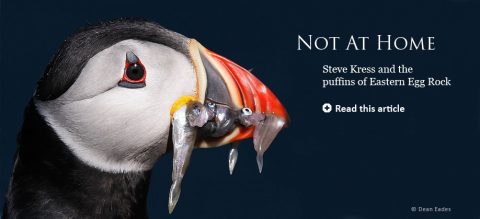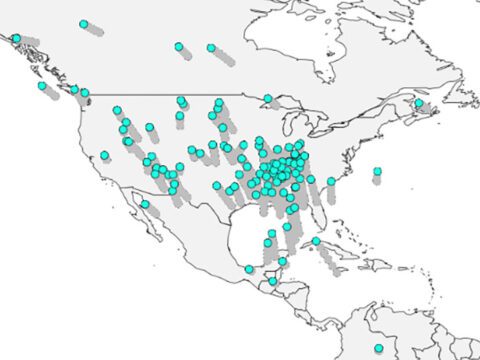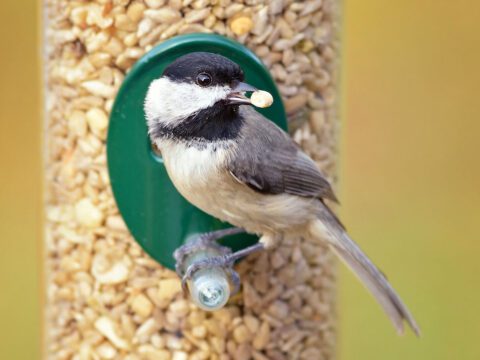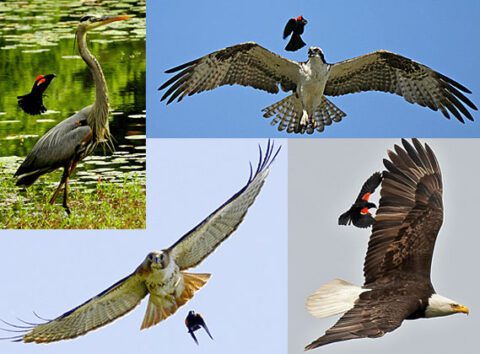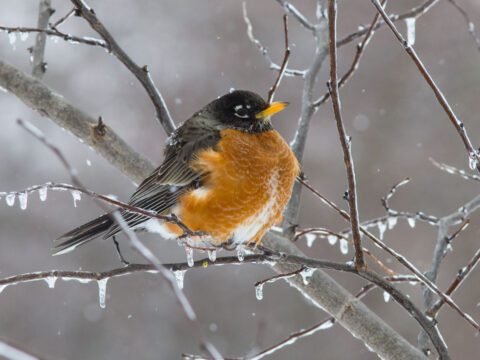Information Seekers: Roosting Black Vultures
By Jack Connor; Photograph by Aurthur Morris/Birds As Art
October 15, 2011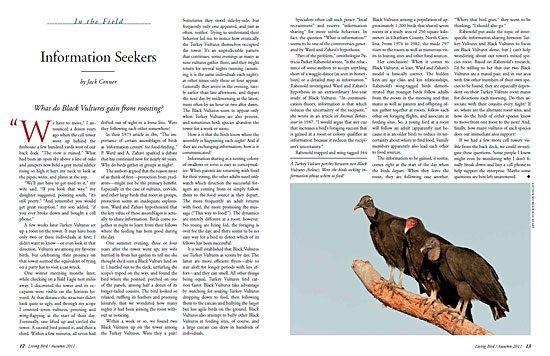
We have to move,” I announced a dozen years ago when the cell tower went up behind the firehouse a few hundred yards west of our back deck. “The view is ruined.” What had been an open sky above a line of oaks and junipers now held a gray metal edifice rising so high it hurt my neck to look at the pipes, wires, and plates at the top.
“We’ll just have to get used to it,” my wife said. “If you look that way,” my daughter suggested, pointing south, “it’s still pretty.” “And remember you would get great reception,” my son added, “if you ever broke down and bought a cell phone.”
A few weeks later Turkey Vultures set up a roost on the tower. It may have been only two or three individuals at first; I didn’t want to know—or even look in that direction. Vultures are among my favorite birds, but celebrating their presence on that tower seemed the equivalent of tying on a party hat to visit a car wreck.
One winter morning months later, while checking on a Bald Eagle nest miles away, I discovered the tower and its occupants were visible on the horizon beyond. At that distance the structure didn’t look quite so ugly, and through my scope I counted seven vultures, preening and wing-flapping at the start of their day. Eventually, one lifted up and circled the tower. A second bird joined it, and then a third. Within a few minutes, all seven had drifted out of sight in a loose line. Were they following each other somewhere?
In their 1973 article in Ibis, “The importance of certain assemblages of birds as ‘information centers’ for food-finding,” P. Ward and A. Zahavi sparked a debate that has continued now for nearly 40 years. Why do birds gather in groups at night?
The authors argued that the reason most of us think of first—protection from predators— might not be the primary benefit. Especially in the case of vultures, corvids, and other large birds that roost in groups, protection seems an inadequate explanation. Ward and Zahavi hypothesized that the key value of these assemblages is actually to share information. Birds come together at night to learn from their fellows where the feeding has been good during the day.
One summer evening, three or four years after the tower went up, my wife hurried in from her garden to tell me she thought she’d seen a Black Vulture land on it. I hustled out to the deck, unfurling the scope’s tripod on the way, and found the bird where she pointed: perched on one of the panels, among half a dozen of its longer-tailed cousins. The bird looked so relaxed, ruffling its feathers and preening leisurely, that we wondered how many nights it had been joining the roost without us noticing.
Within a week or so, we found two Black Vultures up on the tower among the Turkey Vultures. Were they a pair? Sometimes they stood side-by-side, but frequently only one appeared, and just as often, neither. Trying to understand their behavior led me to notice how erratically the Turkey Vultures themselves occupied the tower. It’s an unpredictable pattern that continues: some evenings as many as nine vultures gather there, and they might return for several nights running (assuming it is the same individuals each night); at other times only three or four appear. Generally they arrive in the evening, rarely earlier than late afternoon, and depart the next day by midmorning at the latest, more often by an hour or two after dawn. The Black Vultures seem to appear only when Turkey Vultures are also present, and sometimes both species abandon the tower for a week or more.
How is it that the birds know where the assembly is happening each night? And if they are exchanging information, how is it communicated?
Information sharing at a nesting colony of swallows or terns is easy to conceptualize. When parents are returning with food for their young, the other adults need only watch which direction the successful foragers are coming from or simply follow them to the food source as they depart. The more frequently an adult returns with food, the more promising the message (“This way to food!”). The dynamics are entirely different at a roost, however. No young are being fed, the foraging is over for the day, and there seems to be no easy way for a bird to detect which of its fellows has been successful.
It is well established that Black Vultures use Turkey Vultures as scouts by day. The latter are more efficient flyers—able to stay aloft for longer periods with less effort— and they can smell. All other things being equal, Turkey Vultures find carrion faster. Black Vultures take advantage by watching for soaring Turkey Vultures dropping down to feed, then following them to the carcass and bullying the larger but less agile birds on the ground. Black Vultures also attempt to bully other Black Vultures at feeding sites, of course, and a large carcass can draw in hundreds of individuals.
Specialists often call such piracy “local recruitment” and reserve “information sharing” for more subtle behaviors. In fact, the question “What is information?” seems to be one of the controversies generated by Ward and Zahavi’s hypothesis.
“Part of the problem,” ornithologist Patricia Parker Rabenold wrote, “is the reluctance of some authors to accept anything short of a waggle-dance [as seen in honeybees] or a detailed map as information.” Rabenold investigated Ward and Zahavi’s hypothesis in an extraordinary five-year study of Black Vultures. “In communication theory, information is that which reduces the uncertainty of the recipient,” she wrote in an article in Animal Behaviour in 1987. “I would argue that any cue that increases a bird’s foraging success that is gained at a roost or colony qualifies as information because it reduces the recipient’s uncertainty.”
Rabenold trapped and wing-tagged 344 Black Vultures among a population of approximately 1,200 birds that shared seven roosts in a study area of 250 square kilometers in Chatham County, North Carolina. From 1976 to 1982, she made 797 visits to the roosts as well as numerous visits to baiting sites and other food sources.
Her conclusion? When it comes to Black Vultures, at least, Ward and Zahavi’s model is basically correct. The hidden keys are age class and kin relationships. Rabenold’s wing-tagged birds demonstrated that younger birds follow adults from the roosts in the morning and that mates as well as parents and offspring often gather together at roosts, follow each other on foraging flights, and associate at feeding sites. So, a young bird at a roost will follow an adult (apparently just because it is an older bird) to reduce its uncertainty about where to find food. Family members apparently also lead each other to food sources.
The information to be gained, it seems, comes right at the start of the day when the birds depart. When they leave the roost, they are following one another. “Where that bird goes,” they seem to be thinking, “I should also go.”
Rabenold put aside the topic of interspecific information sharing between Turkey Vultures and Black Vultures to focus on Black Vultures alone, but I can’t help wondering about our tower’s mixed species roost. Based on Rabenold’s research, I’d be willing to bet that our two Black Vultures are a mated pair, and in our area with few other members of their own species to be found, they are especially dependent on their Turkey Vulture roost mates for directions each morning. Do they associate with their cousins every night? If so, where are the alternate roost sites, and how do the birds of either species know to move from one roost to the next? And, finally, how many vultures of each species does our immediate area support?
If we had a few more cell towers visible from the back deck, we could investigate these questions. Some people I know might even be wondering why I don’t finally break down and buy a cell phone to help support the enterprise. Maybe some questions are best left unanswered.

All About Birds
is a free resource
Available for everyone,
funded by donors like you
American Kestrel by Blair Dudeck / Macaulay Library
